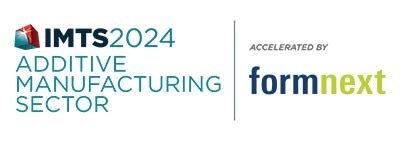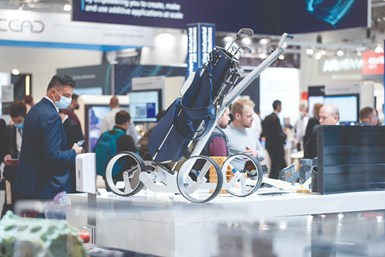Who’s Who Shaping Additive Manufacturing?
Here are some highlights from an episode of AMT’s new IMTS+ series, “Moving on, Moving up,” which features four additive manufacturing leaders discussing their view of the industry’s top trends and challenges.
While attending the Formnext Forum Austin last fall in Texas, I gained some new insights on top trends and challenges driving industrial 3D printing innovation from four additive manufacturing (AM) leaders.
Jacob Nuechterlein, president and founder of Elementum 3D, is a Ph.D. material scientist and metallurgist. He looks forward to making larger parts, whether by wire directed energy deposition (DED) or powder-sprayed DED, which will help cut some of the lead times compared to forgings and castings. He’s also excited about in-process monitoring because it offers internal inspection of the part as it’s being printed.
Ali Forsyth, CEO at Alloy Enterprises, is working with her team to streamline the production of strong yet lightweight aluminum parts.
Stephanie Bonfiglio, director of integration and client relations at i3DMFG, is excited to see improvements enabling serial production at a higher volume and lower cost.
Noah Mostow, business development manager at Phase3D, began his AM career working in the 3D printing lab of Burton Snowboards where he learned about the printers and how to set up the machines.

Memorable Moments and Industry Insights
My first question focused on their most memorable moments from the show. They unanimously highlighted the power of networking, collaboration and the unique familiarity of the event that created an environment for growth and innovation. They also shared some of their personal journeys into the world of AM, underscoring the diverse paths that have led them to the forefront of the industry.
Nuechterlein admitted to knowing nothing about 3D printing until he started his company. “That’s how you learn things, right? I bought a [printer] to learn how to do it and had an idea, so I just jumped in,” he says.
With 20 years of experience, Bonfiglio started with electrical connectors and had an opportunity to jump into a new startup company. “It’s been super exciting. I didn’t know anything about additive, but to see how we’ve grown over the years has been pretty awesome.”
Forsyth came up in the startup ecosystem. She helped develop technologies in the Boston area and just always loved the interface between software and hardware.
Mostow says his whole story is kind of falling into this through luck. “I’m an engineer by trade, and during my senior year at Vermont I connected with Burton Snowboards, who have an entire 3D printing lab,” Mostow says. “We did our project with them, and I fell in love with the technology.”
Game-Changing Innovations
The conversation then delved into groundbreaking technologies and processes. Alloy Enterprises had been featured in the news for its new aluminum manufacturing process, which aims for high through-series production with fully dense 6061 aluminum parts. Forsyth explained how the cost competitiveness of the technology has opened doors for applications in aerospace, industrial equipment and automotive.
Nuechterlein discussed Elementum 3D’s proprietary aluminum alloy, 5083-RAM5, which offers strengths comparable to the 7000 series without the need for heat treatment. The conversation highlighted the industry’s revolution, moving beyond traditional materials like copper.
Bonfiglio talked about i3DMFG’s production-based approach to direct metal laser sintering (DMLS). With open-site licenses, custom parameters and a diverse range of stocked powders, i3DMFG has positioned itself as a leader in AM.
Mostow shed light on Phase3D’s patent-pending, in-process monitoring system, which uses structured light to gather data layer by layer. This technology enhances quality control and is crucial for the transition to Industry 4.0, supporting informed decision-making and scaling production.
Educational Outreach and Industry Advocacy
The manufacturing sector as a whole is struggling to find skilled workers, and AM is no exception. At the event, many presenters hyped it up as the place to attract the next generation or even the current generation that might be considering changing their careers.
When I asked each panelist how they would pitch 3D printing to attract future workers, they each emphasized specific initiatives such as university collaborations, curriculum development and community outreach to underscore the industry’s commitment to nurturing talent and fostering a diverse workforce.
Industry Challenges
To conclude the conversation, I asked their thoughts on the biggest challenge facing the AM industry. Here’s what they had to say:
Nuechterlein: “The biggest challenge, I believe, facing us right now is the lack of printer manufacturer technicians. There are not many people who are experts that can come out and fix the machines.”
Mostow: “I think that’s part of the puzzle, but we need to gather more data. If we want to get to that production environment and actual lights-out manufacturing, we need to understand what is going on within these technologies.”
Bonfiglio: “I would add that standardization of additive manufacturing is so broad right now.”
Forsyth: “One that I think we are just on the cusp of is the circularity and sustainability of our materials. So, not just thinking about the printing process or additive process, but how is the material made, how much carbon does that take, what happens with reuse or recycling of the material? How can we make these materials as circular as possible, reducing CO2 emissions?”
Shape the Future of Industrial 3D Printing
Join the conversation at upcoming Formnext events, a brand that needs no introduction in the AM community. Mesago Messe Frankfurt has produced Formnext for years, growing the show to be the largest industrial AM event in the world. Now, with the help of AMT — The Association For Manufacturing Technology and Gardner Business Media, the event has a growing presence in the U.S.:

-
AM Sector, accelerated by Formnext, at IMTS 2024, Sept. 9-14
- Formnext Chicago, April 8-10, 2025
Watch the full interview at IMTS.com/MovingUp1.
Read Next
Crushable Lattices: The Lightweight Structures That Will Protect an Interplanetary Payload
NASA uses laser powder bed fusion plus chemical etching to create the lattice forms engineered to keep Mars rocks safe during a crash landing on Earth.
Read More3D Printed Polymer EOAT Increases Safety of Cobots
Contract manufacturer Anubis 3D applies polymer 3D printing processes to manufacture cobot tooling that is lightweight, smooth and safer for human interaction.
Read MoreAlquist 3D Looks Toward a Carbon-Sequestering Future with 3D Printed Infrastructure
The Colorado startup aims to reduce the carbon footprint of new buildings, homes and city infrastructure with robotic 3D printing and a specialized geopolymer material.
Read More
















